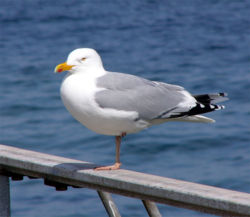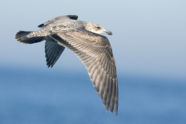Herring Gull
2007 Schools Wikipedia Selection. Related subjects: Birds
| iHerring Gull | ||||||||||||||
|---|---|---|---|---|---|---|---|---|---|---|---|---|---|---|
 Adult
|
||||||||||||||
|
|
||||||||||||||
 Least Concern (LC) |
||||||||||||||
| Scientific classification | ||||||||||||||
|
||||||||||||||
|
|
||||||||||||||
| Larus argentatus Pontoppidan, 1763 |
The Herring Gull, Larus argentatus, is a large gull which breeds across North America, Europe and Asia. It migrates further south in winter. Some are permanent residents on the lower Great Lakes and the east coast of North America. Herring Gulls are also abundant around inland garbage dumps, and some have even adapted to life in inland cities.
The taxonomy of the Herring Gull / Lesser Black-backed Gull complex is very complicated, different authorities recognising between two and eight species.
This group has a ring distribution around the northern hemisphere. Differences between adjacent forms in this ring are fairly small, but by the time the circuit is completed, the end members, Herring Gull and Lesser Black-backed Gull, are clearly different species.
Adult Herring Gulls are similar to Ring-billed Gulls but are much larger, have pinkish legs, and a much thicker yellow bill with more pronounced gonys. First-winter Herring Gulls are much browner, but second and third-winter birds can be confusing since soft part colors are variable and third-year Herring Gull often show a ring around the bill. Such birds are most easily distinguished by the larger size and larger bill of Herring Gull.
The Association of European Rarities Committees recognises six species:
- Herring Gull, Larus argentatus
- American Herring Gull, Larus smithsonianus
- Caspian Gull, Larus cachinnans
- Yellow-legged Gull, Larus michahellis
- East Siberian Gull, Larus vegae
- Armenian Gull, Larus armenicus
Adults are easily identified by their size, pale grey back and the red spot on the beak. Legs are pink at all ages. The bird depicted is the western European race Larus argentatus argenteus. The Scandinavian race L. a. argentatus is slightly larger and darker, with more white in the wing tips.
The North American American Herring Gull is similar to argentatus, except that immature birds tend to be darker and more uniformly brown.
These are omnivores like most Larus gulls, and will scavenge on rubbish tips and elsewhere, as well as seeking suitable small prey in fields or on the coast, or robbing plovers or lapwings of their catches.
Eggs, usually three, are laid on the ground or cliff ledges in colonies, and are defended vigorously by this large gull. The loud laughing call is well-known in the northern hemisphere.
Parasites of Herring gulls include the fluke Microphallus piriformes.

